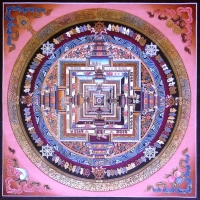 |
||
|
Ganesh and Skanda - the first Gods Om Shri Ganeshaya Namah Sanatana means eternal, never ending and never starting... 

Two Sons ...of God Shiva...
The
above images of Ganesh and Skanda published with kind permission of the
Murugan.org website: Life on Earth has ONE history of the Beginning... Or read the following text - it is also available here. On February 21, 2013, my necklace of Lord Ganesh miraculously fell on the ground when I was leaving one person at my workplace here. I took the necklace up from the ground and, to my amazement, the silver chain was not broken, neither was it released. I put it back over my head as if nothing happened. For me, this was a miracle, so I decided to study Lord Ganesh and other Hindu deities especially in relation to mystical powers connected both to deities and people worshiping these deities. The Hindu milk miracle was one of the most famous miraculous events. It occurred in September 1995. What actually happened was that the statues of the Hindu deity Ganesha allegedly "drank" milk. Devotees spread this news, because they noticed that milk disappeared right from under the Ganesha's statues. This attracted a great attention of many people and the media. Who Is Lord Ganesh?Ganesh, also known as Pillaiyar, Ganapati or Vinayaka, is one of the best-known and most widely worshipped deities in Hinduism. Prayers to Ganesh start at the beginning of any ritual. He is the god of wisdom and intellect. His most powerful attribute is that he is the Remover of Obstacles. He belongs to the group of zoomorphic deities because he has a head from the elephant. Ganesh, Ganesha, Vinayak, or Ganapati - "Leader of the Groups" (or "Lord of Hosts") are the most common names for Lord Ganesh. The title "Leader of the Groups" (or "Lord of Hosts") appears in the Rig Veda. The Vedic god Brhaspati ("Lord of Prayer and Devotion") is tightly associated with Ganesha. Bible, too, knows the term "Lord of Hosts". Not many people do know that the Biblical YHWH or Elohim are actually plural words meaning "hosts" or "heavenly armies". These words are very close to the meaning the Sanskrit term Ganapati ("Lord of Hosts") conveys. Lord Shiva decapitated and reanimated Ganesha when he returned home after slaughtering demons. The Shiva's consort Parvati created Ganesh because she felt alone when her husband went away to fight with demons. When Lord Shiva reappeared back home at the Kailash Mountain in the Himalayas, Ganesh, the Parvati's protector, wanted to stop him from going into the Parvati's and Shiva's abode because these two had not met each other yet. The Ganesha's courage to stop Shiva infuriated Shiva to such an extent that he severed his head. Parvati demanded Shiva to restore the Ganesha's life. Shiva agreed, but he could not find his head. When an elephant suddenly came into his view, he decided to give Ganesha this elephant's head and he then reanimated Ganesha back to life, the Puranas say. Ganesh Chaturthi is a very big Hindu festival that occurs in the Bhadrapad month (August 23 - September 23). It is quite easy to calculate this date. Just look at the moon calendar. In the Bhadrapad month this year (2013), the dark or new moon occurs on September 5 (the new moon just next prior to September 5 occurs on August 6). The Ganesha's birthday falls on the fourth day after the new moon in this auspicious month, which is September 9. You may use the same approach to calculate the beginning of the Ganesh Chaturthi festival in any year. The term Chaturthi denotes the 4th day after the new moon. The Ganesh Chaturthi festival culminates in 10 or 11 days when devotees immerse the images (murtis) of Ganesha into the sea or water. This is because water is the symbol of life, creation and the beginning. Immersion of these earthen statues into water also signifies the return of Ganesha to his mother (water is the symbol of womanhood) and that all forms change, but the truth does not. A body immersed in water becomes energy to other life forms. Water is the symbol of primeval existence that does not end but lasts. Miracles In HinduismHinduism and miracles go hand in hand. They have their place in the Puranas, the Mahabharata and in modern books, too. Humiliation of Draupadi (Mahabharata) went to such an extent that when the Kurus wanted to see her naked, her sari, after Dushasana started unwrapping its layers, rather kept getting extended. This Lord Krishna's miracle saved Draupadi from being humiliated. Manasa Devi resurrected Chand Saudagar's sons from the dead. A number of Hindu gurus have healing powers, too. A lot of websites mention Sai Baba's miraculous healings or materialization of objects. Particularly this is both the source of his fame and controversy. Recognized Hindu spiritual leaders say that Babaji - "the eternal yogi" (Yogi-Christ of modern India) - is immortal and that he sometimes appears to people. One of such reliable sources was a well-respected yogi and guru Paramahansa Yogananda (1893-1952) who mentions Babaji in his bestselling book Autobiography of a Yogi. Hinduism is familiar with so many miracles that you will find them in categories. Such a categorization is quite unknown in other religions. Tantra, too, is a secret path often associated with mystical powers and miracles. The Hindus know eight types of mystical powers the yogis refer to
as Ashta Ma Siddhis. Siddhis (not all schools of yoga deal with this
topic), belong to yoga. For example, the ANIMA term classifies a condition
when a yogi becomes the size of an atom and enters into the smallest
parts of life.  |
||
|
|
||
